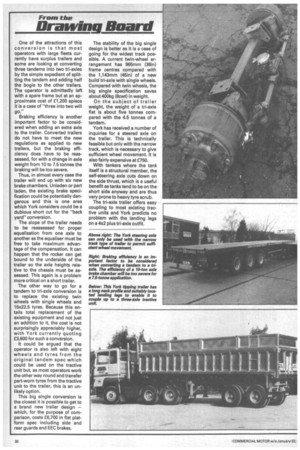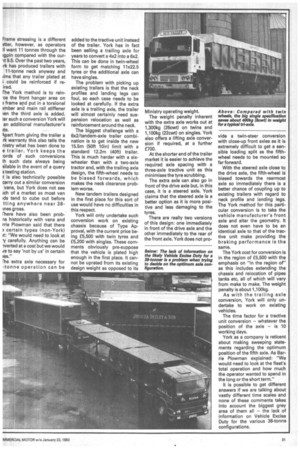I I T " I
Page 31

Page 32

Page 33

If you've noticed an error in this article please click here to report it so we can fix it.
by Graham Montgomeri6 How to convert so as to operate at 38-tonnes? York Trailers' technical sales manager talks about the permutations available
E BIGGEST HEADACHE for erators looking forward to erating at 38-tonnes at the 3ment is deciding which hide combination to go for. 43 axles are required, but 'ere should the extra axle be :ated?
fork Trailer Company is in the ppy position of offering a lety of conversions which able the operator to have the lra axle on the trailer in single twin-wheeled form, selfered or fixed, on the tractive it in front of or behind the ve axle, and so on and so on. ving a technical finger in so iny possible pies, York is thus theoretically without any particular marketing bias, so the views of the company and of technical sales manager Barrie Plowman should be of particular interest.
In terms of modifying the trailer to reach the magic number of five axles, York claims that it is comparatively easy to convert the majority of existing tandems. "Technically we can convert practically anything," says Barrie.
Tankers and tippers are the critical cases as the former are mainly chassisless so it has to be verified that the tank is both strong enough and physically large enough to operate at higher weights.
With tippers, it is a case of seeing that the ram is of sufficient capacity.
The majority of tandems are fitted with twin wheels and 11x22.5 tyres and one comparatively simple way of converting to a tri-axle is to add on another axle to the same tyre and wheel specification.
Perhaps "simple" is the wrong word to use as in most cases the existing suspension has to be relocated. It is possible to reach a satisfactory load distribution by merely adding the extra axle in front of the existing bogie but these cases are in the minority.
York has to . make sure that such a conversion would meet the new legal requirements on axle spacing and minimum overall length. This is a critical problem at anything less than 9.7m (32ft), which York regards as a "warning sign". It is technically possible, but a lot of information is needed on the tractive unit to be used before a decision can be given.
Adding an extra axle to match the existing specification of twin-wheels and 11x22.5 tyres takes five days and costs £2,400 at current York prices. This figure includes matching the suspension and fitting of sideguards as well as the cost of four new wheels and tyres. One of the attractions of this conversion is that most operators with large fleets currently have surplus trailers and some are looking at converting three tandems into two tri-axles by the simple expedient of splitting the tandem and adding half the bogie to the other trailers. The operator is admittedly left with a spare frame but at an approximate cost of £1,200 apiece it is a case of "three into two will go."
Braking efficiency is another important factor to be considered when adding an extra axle to the trailer. Converted trailers do not have to meet the new regulations as applied to new trailers, but the braking efficiency does have to be reassessed, for with a change in axle weight from 10 to 7.5 tonnes the braking will be too severe.
Thus, in almost every case the trailer will end up with six new brake chambers. Unladen or part laden, the existing brake specification could be potentially dangerous and this is one area which York considers could be a dubious short cut for the "back yard" conversion.
The slope of the trailer needs to be reassessed for proper equalisation from one axle to another as the equaliser must be free to take maximum advantage of the compensation. It can happen that the rocker can get bound to the underside of the trailer so the axle heights relative to the chassis must be assessed. This again is a problem more critical on a short trailer.
The other way to go for a tandem to tri-axle conversion is to replace the existing twin wheels with single wheels and 15x22.5 tyres. Because this entails total replacement of the existing equipment and not just an addition to it, the cost is not surprisingly appreciably higher, with York currently quoting £3,600 for such a conversion.
It could be argued that the operator is also left with eight wheels and tyres from the original tandem spec which could be used on the tractive unit but, as most operators work the other way round and transfer part-worn tyres from the tractive unit to the trailer, this is an unlikely option.
This big single conversion is the closest it is possible to get to a brand new trailer design — which, for the purpose of comparison, costs £6,700 in flat platform spec including side and rear guards and EEC brakes. The stability of the big single design is better as it is a case of going for the widest track possible. A current twin-wheel arrangement has 965mm (38in) frame centres compared with the 1,143mm (45in) of a new build tri-axle with single wheels. Compared with twin wheels, the big single specification saves about 400kg (8cwt) in weight.
On the subject of trailer weight, the weight of a tri-axle flat is about five tonnes compared with the 4.5 tonnes of a tandem.
York has received a number of inquiries for a steered axle on the trailer. This is technically feasible but only with the narrow track, which is necessary to give sufficient wheel movement. It is also fairly expensive at £750.
With tankers where the tank itself is a structural member, the self-steering axle cuts down on the side thrust, which is a useful benefit as tanks tend to be on the short side anyway and are thus very prone to heavy tyre scrub.
The tri-axle trailer offers easy coupling to most existing tractive units and York predicts no problem with the landing legs on a 4x2 plus tri-axle outfit. Frame stressing is a different atter, however, as operators ll want 11 tonnes through the igpin compared with the curIt 9.5. Over the past two years, irk has produced trailers with 11-tonne neck anyway and iims that any trailer plated at i could be reinforced if reired.
rhe York method is to rein'ce the front hanger area on a frame and put in a torsional amber and main rail stiffener ten the third axle is added. :er such a conversion York will an additional manufacturer's
4part from giving the trailer a rk warranty this also tells the nistry what has been done to e trailer. York keeps the :ords of such conversions :h such data always being ailable in the event of a query a testing station.
t is also technically possible carry out a similar conversion vans, but York does not see ich of a market as most van ids tend to cube out before tting anywhere near 38Ines gross.
rhere have also been probns historically with vans and rrie Plowman said that there 3 certain types (non-York) it: "We would need to look at y carefully. Anything can be 'averted at a cost but we would re to say 'not by us' in certain
added to the tractive unit instead of the trailer. York has in fact been selling a trailing axle for years to convert a 4x2 into a 6x2. This can be done in twin-wheel form to get matching 11x22.5 tyres or the additional axle can have singles.
The problem with picking up existing trailers is that the neck profiles and landing legs can foul, so each case needs to be looked at carefully. If the extra axle is a trailing axle, the trailer will almost certainly need suspension relocation as well as reinforcement around the neck.
The biggest challenge with a 6x2/tandem-axle trailer combination is to get inside the new 15.5m (50ft 10in) limit with a standard 12.2m (40ft) trailer. This is much harder with a sixwheeler than with a two-axle tractor and, with the trailing axle design, the fifth-wheel needs to be biased forwards, which makes the neck clearance problem worse.
New tandem trailers designed in the first place for this sort of use would have no difficulties in this respect.
York will only undertake such conversion work on existing chassis because of Type Approval, with the current price being £5,500 with twin tyres and £5,200 with singles. These comments obviously pre-suppose that the vehicle is plated high enough in the first place. It cannot be uprated from its existing design weight as opposed to its Ministry operating weight.
The weight penalty inherent with the extra axle works out at 1,300kg (26cwt) on twins and 1,100kg (22cwt) on singles. York also offers a lifting axle conversion if required, at a further £700.
At the shorter end of the trailer market it is easier to achieve the required axle spacing with a three-axle tractive unit as this minimises the tyre scrubbing.
The extra axle can also go in front of the drive axle but, in this case, it is a steered axle. York claims that the steered axle is a better option as it is more positive and less damaging to the tyres.
There are really two versions of this design: one immediately in front of the drive axle and the other immediately to the rear of the front axle. York does not pro vide a twin-steer conversion with close-up front axles as it is extremely difficult to get a sen sible loading split as the fifthwheel needs to be mounted so far forward.
With the steered axle close to the drive axle, the fifth-wheel is biased towards the rearmost axle so immediately there is a better chance of coupling up to existing trailers with regard to neck profile and landing legs.
The York method for this particular conversion is to take the vehicle manufacturer's front axle and alter the geometry. It does not even have to be an identical axle to that of the tractive unit make providing the braking performance is the same.
The York cost for conversion is in the region of £5,500 with the emphasis on "in the region of" as this includes extending the chassis and relocation of pipes tanks etc, all of which will vary from make to make. The weight penalty is about 1,100kg.
As with the trailing axle conversion, York will only undertake to work on existing vehicles.
The time factor for a tractive unit conversion — whatever the position of the axle — is 10 working days.
York as a company is reticent about making sweeping state ments regarding the optimum position of the fifth axle. As Barrie Plowman explained: "We would need to look at the fleet's total operation and how much the operator wanted to spend in the long or the short term."
It is possible to get different answers if we are talking about vastly different time scales and none of these comments takes into account the biggest grey area of them all — the lack of information on Vehicle Excise Duty for the various 38-tonne configurations.




















































































